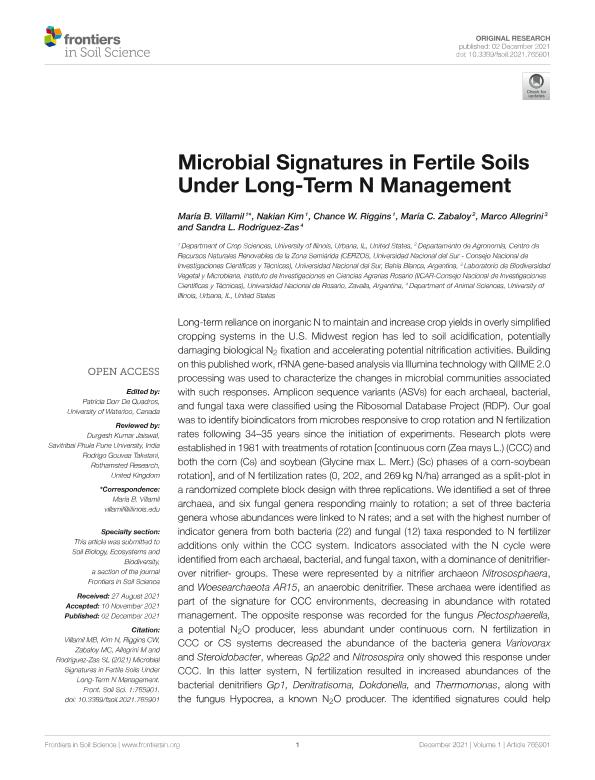Mostrar el registro sencillo del ítem
dc.contributor.author
Villamil, Maria Bonita

dc.contributor.author
Kim, Nakian
dc.contributor.author
Riggins, Chance W.
dc.contributor.author
Zabaloy, Maria Celina

dc.contributor.author
Allegrini, Marco

dc.contributor.author
Rodríguez Zas, Sandra L.
dc.date.available
2022-09-26T17:13:07Z
dc.date.issued
2021-12-02
dc.identifier.citation
Villamil, Maria Bonita; Kim, Nakian; Riggins, Chance W.; Zabaloy, Maria Celina; Allegrini, Marco; et al.; Microbial Signatures in Fertile Soils Under Long-Term N Management; Frontiers Media; Frontiers in Soil Science; 1; 02-12-2021; 1-22
dc.identifier.uri
http://hdl.handle.net/11336/170464
dc.description.abstract
Long-term reliance on inorganic N tomaintain and increase crop yields in overly simplified cropping systems in the U.S. Midwest region has led to soil acidification, potentially damaging biological N2 fixation and accelerating potential nitrification activities. Building on this published work, rRNA gene-based analysis via Illumina technology with QIIME 2.0 processing was used to characterize the changes in microbial communities associated with such responses. Amplicon sequence variants (ASVs) for each archaeal, bacterial, and fungal taxa were classified using the Ribosomal Database Project (RDP). Our goal was to identify bioindicators from microbes responsive to crop rotation and N fertilization rates following 34?35 years since the initiation of experiments. Research plots were established in 1981 with treatments of rotation [continuous corn (Zea mays L.) (CCC) and both the corn (Cs) and soybean (Glycine max L. Merr.) (Sc) phases of a corn-soybean rotation], and of N fertilization rates (0, 202, and 269 kg N/ha) arranged as a split-plot in a randomized complete block design with three replications. We identified a set of three archaea, and six fungal genera responding mainly to rotation; a set of three bacteria genera whose abundances were linked to N rates; and a set with the highest number of indicator genera from both bacteria (22) and fungal (12) taxa responded to N fertilizer additions only within the CCC system. Indicators associated with the N cycle were identified from each archaeal, bacterial, and fungal taxon, with a dominance of denitrifier over nitrifier- groups. These were represented by a nitrifier archaeon Nitrososphaera, and Woesearchaeota AR15, an anaerobic denitrifier. These archaea were identified as part of the signature for CCC environments, decreasing in abundance with rotated management. The opposite response was recorded for the fungus Plectosphaerella, a potential N2O producer, less abundant under continuous corn. N fertilization in CCC or CS systems decreased the abundance of the bacteria genera Variovorax and Steroidobacter, whereas Gp22 and Nitrosospira only showed this response under CCC. In this latter system, N fertilization resulted in increased abundances of the bacterial denitrifiers Gp1, Denitratisoma, Dokdonella, and Thermomonas, along with the fungus Hypocrea, a known N2O producer. The identified signatures could help future monitoring and comparison across cropping systems as we move toward more sustainable management practices. At the same time, this is needed primary information to understand the potential for managing the soil community composition to reduce nutrient losses to the environment.
dc.format
application/pdf
dc.language.iso
eng
dc.publisher
Frontiers Media
dc.rights
info:eu-repo/semantics/openAccess
dc.rights.uri
https://creativecommons.org/licenses/by/2.5/ar/
dc.subject
ARCHAEA
dc.subject
BACTERIA
dc.subject
FUNGI
dc.subject
NIITROGEN
dc.subject
MAIZE
dc.subject
SOYBEAN
dc.subject
MONOCULTURE
dc.subject
ROTATION
dc.subject.classification
Ciencias del Suelo

dc.subject.classification
Agricultura, Silvicultura y Pesca

dc.subject.classification
CIENCIAS AGRÍCOLAS

dc.subject.classification
Biología Celular, Microbiología

dc.subject.classification
Ciencias Biológicas

dc.subject.classification
CIENCIAS NATURALES Y EXACTAS

dc.title
Microbial Signatures in Fertile Soils Under Long-Term N Management
dc.type
info:eu-repo/semantics/article
dc.type
info:ar-repo/semantics/artículo
dc.type
info:eu-repo/semantics/publishedVersion
dc.date.updated
2022-09-16T10:30:22Z
dc.identifier.eissn
2673-8619
dc.journal.volume
1
dc.journal.pagination
1-22
dc.journal.pais
Suiza

dc.journal.ciudad
Basel
dc.description.fil
Fil: Villamil, Maria Bonita. University of Illinois at Urbana; Estados Unidos
dc.description.fil
Fil: Kim, Nakian. University of Illinois at Urbana; Estados Unidos
dc.description.fil
Fil: Riggins, Chance W.. University of Illinois at Urbana; Estados Unidos
dc.description.fil
Fil: Zabaloy, Maria Celina. Consejo Nacional de Investigaciones Científicas y Técnicas. Centro Científico Tecnológico Conicet - Bahía Blanca. Centro de Recursos Naturales Renovables de la Zona Semiárida. Universidad Nacional del Sur. Centro de Recursos Naturales Renovables de la Zona Semiárida; Argentina. Universidad Nacional del Sur. Departamento de Agronomía; Argentina
dc.description.fil
Fil: Allegrini, Marco. Consejo Nacional de Investigaciones Científicas y Técnicas. Centro Científico Tecnológico Conicet - Rosario. Instituto de Investigaciones en Ciencias Agrarias de Rosario. Universidad Nacional de Rosario. Facultad de Ciencias Agrarias. Instituto de Investigaciones en Ciencias Agrarias de Rosario; Argentina
dc.description.fil
Fil: Rodríguez Zas, Sandra L.. University of Illinois at Urbana; Estados Unidos
dc.journal.title
Frontiers in Soil Science
dc.relation.alternativeid
info:eu-repo/semantics/altIdentifier/url/https://www.frontiersin.org/articles/10.3389/fsoil.2021.765901/full
dc.relation.alternativeid
info:eu-repo/semantics/altIdentifier/doi/http://dx.doi.org/10.3389/fsoil.2021.765901
Archivos asociados
